Charged particles and magnetic fields
What is the most important discovery or invention in history?
There are many possible answers to this question, but the discovery of the interaction between electricity and magnetism, and the resultant ability to produce movement, must rank as one of the most significant developments in physics in terms of impact on everyday life.
This work was carried out by Michael Faraday (1791–1867), whose work on electromagnetic rotation in 1821 gave us the electric motor. He was also instrumental in the work which brought electricity into everyday life, with the discovery of the principle of the transformer and generator in 1831.
However, not everyone could see its potential. William Gladstone (1809–1898), the then Chancellor of the Exchequer and subsequently four-time Prime Minister of Great Britain, challenged Faraday on the practical worth of this new discovery – electricity. Faraday’s response was ‘Why, sir, there is every probability that you will soon be able to tax it!’ In fact it was more than 150 years later that this prediction of Faraday became true.
In the last section we explored the electric field that surrounds a stationary electric charge.
Questions to consider and discuss:
When a charged particle moves a magnetic field is generated. A current-carrying wire will have a magnetic field around it. This can be demonstrated with simple experiments. It is also possible to investigate the shape of this magnetic field, as well as how to increase, decrease and change the direction of the field.
It is possible to remember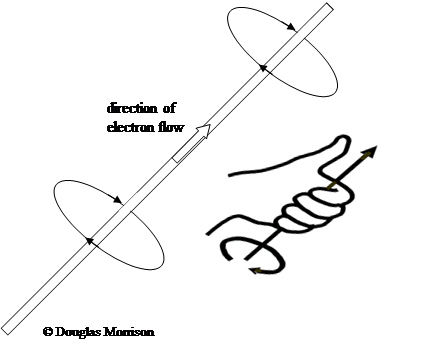 the
the
direction of the magnetic field
round a current-carrying wire
for electron flow using the
left-hand grip rule.
The electric field surrounding a stationary charged particle and the magnetic field surrounding a moving charged particle are not two entirely separate fields. The work of James Clark Maxwell (1831–1879), an Edinburgh-based scientist, identified the theory of electromagnetism and the equations describing the interaction between electric and magnetic fields.
What happens when two magnetic fields interact? Consider a simple case, e.g. bringing two bar magnets together. The magnets will each attract or repel due to an interaction between the magnetic fields surrounding each of the magnets.
So, what will happen when a moving electric charge is brought into a static magnetic field? The moving electric charge is surrounded by a magnetic (electromagnetic) field, which will interact with the static magnetic field or with any other magnetic or electromagnetic field. The moving electric charge will therefore experience a force. This can be compared to an object with mass experiencing a force when in a gravitational field.
Simple rules can be used to determine the direction of force on a charged particle in a magnetic field.
For electron flow, the right-hand motor rule applies:
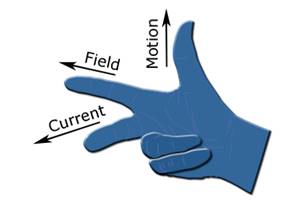
© Douglas Morrison.
The following images show how the right-hand motor rule (for electron flow) works for a motor (images courtesy of www.flashlearning.co.uk):
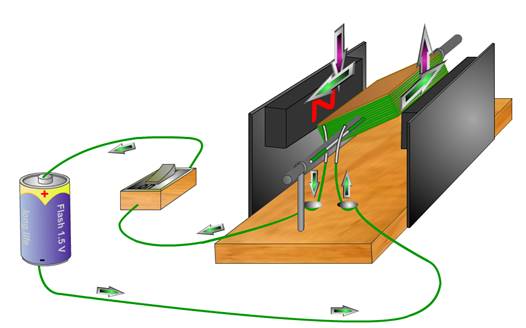
In the image above, from the current flow marked in green and the direction of unbalanced force (and therefore motion) in purple, predict the direction of the magnetic field.
Check your prediction in the image below. The field is marked in cream.
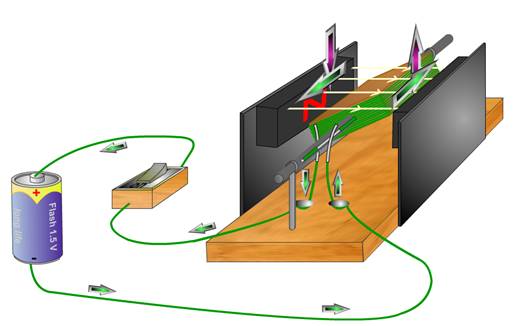
For conventional current (i.e. a flow of positive charge) the left-hand motor rule applies:
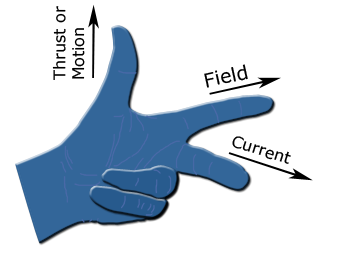
© Douglas Morrison.
Source: http://www.kgsorkney.com/uploads/1/4/9/3/14935550/2._2c_charged_particles_in_magnetic_fields_tcm4-665526.doc
Web site to visit: http://www.kgsorkney.com/
Author of the text: © Learning and Teaching Scotland 2011
If you are the author of the text above and you not agree to share your knowledge for teaching, research, scholarship (for fair use as indicated in the United States copyrigh low) please send us an e-mail and we will remove your text quickly. Fair use is a limitation and exception to the exclusive right granted by copyright law to the author of a creative work. In United States copyright law, fair use is a doctrine that permits limited use of copyrighted material without acquiring permission from the rights holders. Examples of fair use include commentary, search engines, criticism, news reporting, research, teaching, library archiving and scholarship. It provides for the legal, unlicensed citation or incorporation of copyrighted material in another author's work under a four-factor balancing test. (source: http://en.wikipedia.org/wiki/Fair_use)
The information of medicine and health contained in the site are of a general nature and purpose which is purely informative and for this reason may not replace in any case, the council of a doctor or a qualified entity legally to the profession.
The following texts are the property of their respective authors and we thank them for giving us the opportunity to share for free to students, teachers and users of the Web their texts will used only for illustrative educational and scientific purposes only.
All the information in our site are given for nonprofit educational purposes
The information of medicine and health contained in the site are of a general nature and purpose which is purely informative and for this reason may not replace in any case, the council of a doctor or a qualified entity legally to the profession.
www.riassuntini.com